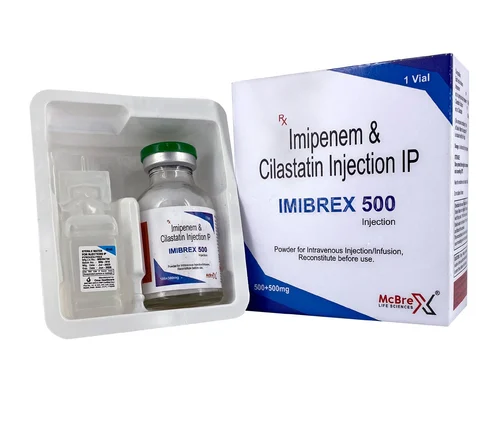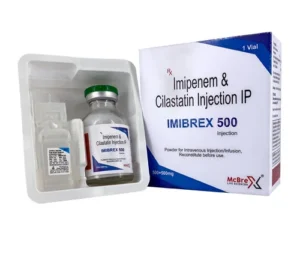
Imipenem
Imipenem is a broad-spectrum antibiotic in the carbapenem class. It is used to treat severe bacterial infections by Gram-positive and Gram-negative bacteria. Imipenem inhibits cell wall synthesis, which leads to the death of bacteria. Its administration is usually in combination with cilastatin. Cilastatin prevents the breakdown of imipenem in the kidney to enhance its effectiveness.
Drug Class
Imipenems drug class is Carbapenem Antibiotics.
Uses of Imipenem
Treatment of Infections
-
- Pneumonia
- Urinary tract infections (UTIs)
- Abdominal infections
- Skin and soft tissue infections
- Bone and joint infections
- Meningitis
- Septicemia
- Intra-abdominal infections
Side Effects of Imipenem
Common Side Effects
- Nausea
- Vomiting
- Diarrhea
- Rash
- Headache
Serious Side Effects
- Seizures (especially in high doses)
- Anaphylaxis (hypersensitivity)
- Liver enzyme elevation (AST, ALT)
- Renal impairment (especially in patients with pre-existing kidney issues)
- Superinfection (overgrowth of non-susceptible organisms)
Dosage
Adults
- The adult dose is 500 mg to 1 g every 6 to 8 hours (IV or IM)
- Maximum Dose is 4 g per day
- In case of Severe Infections, the patient may require higher doses (up to 1 g every 6 hours)
Pediatric Dose
- Typically: 15-25 mg/kg every 6 to 8 hours
- Maximum Dose is 100 mg/kg/day
Renal Impairment Adjustments
- If CrCl < 30 mL/min, then reduce the dose or increase the interval.
Drug Interactions
- Probenecid: Increases plasma levels by inhibiting renal excretion.
- Imipenem decreases the Valproic acid’s effectiveness. It can cause seizures.
- CNS Depressants-000000 Increased risk of seizures.
- When administered with Other Nephrotoxic Drugs, it can increase the risk of renal toxicity.
- Diuretics (especially loop diuretics) can increase the risk of nephrotoxicity.
Contraindications
- Hypersensitivity to Imipenem or other Carbapenems
- History of seizures or neurological disorders
- Severe renal impairment (without dose adjustment)
- Pregnancy (Category C) – Use only when necessary.
- Lactation – Caution is advised; use only if the benefit justifies the risk.
Popular Brand Names
| Brand Name | Active Ingredients | Strengths | Formulation | Common Uses |
| Primaxin | Imipenem, Cilastatin | 500 mg, 1 g | IV or IM injection | Severe infections, UTI, pneumonia |
| Tienam | Imipenem, Cilastatin | 500 mg, 1 g | IV or IM injection | Pneumonia, sepsis, intra-abdominal infections |
| Imipenem-Cilastatin | Imipenem, Cilastatin | 250 mg, 500 mg, 1 g | IV or IM injection | Abdominal, urinary tract, skin infections |
Precautions
- Adjust the dose for patients with renal dysfunction.
- Discontinue immediately if signs of allergy (anaphylaxis) occur.
- Caution in Seizure History because there are chances of CNS toxicity at high doses.
Monitoring Parameters
- Monitor renal function ( Serum creatinine and urine output).
- Check Liver Enzymes such as AST and ALT during prolonged therapy.
- Watch for signs of seizures.
Administration
- Administer through Intravenous or intramuscular route.
- Slow IV infusion to minimize seizure risk.
Conclusion
Imipenem is a potent broad-spectrum carbapenem antibiotic used to treat severe infections. Cilastatin is included in its formulation because it prevents its renal degradation. It is a very effective medicine, but dose adjustments are critical for patients with renal impairment.
